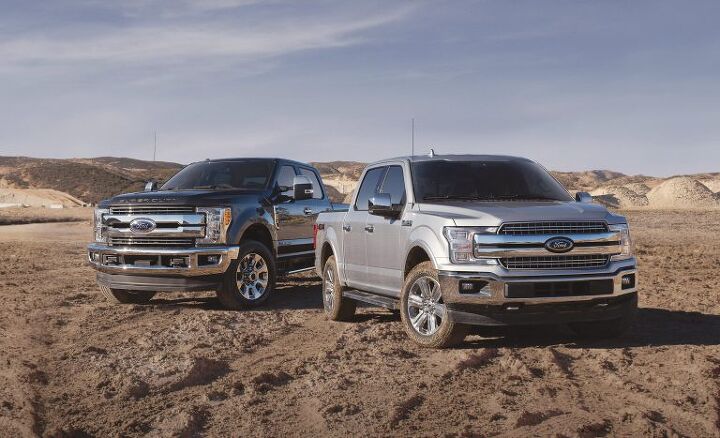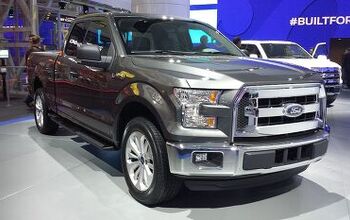Is the Aluminum F-Series Still 'Built Ford Tough?'

Listen, we’re not going to pretend that Ford’s F-Series is bulletproof. There have been enough recalls of the twelfth-generation’s transmission for us to immediately be accused of being the biggest and fattest of lairs were we to make that claim. However, as America’s best-selling model and an exceptionally popular fleet vehicle, it’s in the company’s best interest to make sure the F-150 is not a turd.
Ford took a risk when it went with an aluminum body for the current-gen model, inviting claims from rival manufacturers that it was no longer a serious contender in the pickup market, as real trucks have steel beds. While Chevrolet’s advertorial “ testing procedures” often fell outside the boundaries of what a rational truck owner would do, Ford’s rival was attempting to creating a narrative where saying something was “built Ford tough” could be a considered an insult.
As the aluminum-bodied F-Series has been around since 2015, the Highway Loss Data Institute (HLDI) was able to compile some meaningful collision claim data on the current generation to see how it stacked up against its predecessor.
Ultimately, it’s goodish news. While the frequency of collision claims has risen about 7 percent on Ford’s famous pickup, possibly due to the enhanced malleability of aluminum, overall claim severity is down by 7 percent — thanks largely to cheaper repair costs.
Those lessened fix-it fees are due in part to the F-Series’ modular architecture, which was intentionally designed by the manufacturer to be as repair-friendly as possible. Ford also took strides to educate dealers and insurers on how to cope with the more finicky metal. Dealerships were likewise encouraged to purchase the necessary equipment for servicing and repairs via a voluntary Collision Repair Program, sometimes with extra help from the automaker to ensure appropriate and effective national coverage.
According to Automotive News, it was no small feat. “It was our moonshot,” Dave Johnson, Ford’s global director of service engineering operations, told the outlet in an interview. “We wanted them to be insurable on par with a steel F-150.”
However, the fact remains that aluminum still deforms more easily than steel and requires different tools and training to repair. While we could debate the safety merits of aluminum vs steel all day, likely reaching no consensus other than it all depends on how the car is built, Ford’s pickup certainly isn’t sweating its IIHS crash-test results right now. Yet it only takes about three seconds of memory bank searching to recall that Ford took some heat in 2015 over costly repair bills for the aluminum F-Series. Fortunately for Ford, State Farm Insurance and the Highway Loss Data Institute say things have evened out.
“Given the fact it was aluminum intensive, and prior aluminum vehicles indicated collision claim severities increased, there was concern the same would occur with the F-150,” Matt Moore, senior vice president of the HLDI explained. “Simply put, when we look at the overall losses relative to the other pickup trucks, there’s not a change, which was not consistent with expectations.”
Does that make the current F-Series a better truck than what the competition has on offer?
Not really. But it certainly isn’t a worse truck because of said materials — especially considering that both the Ram 1500 and Chevy Silverado now incorporate some amount of aluminum in their construction, as well. That means Chevy’s comparative dent test is largely irrelevant at this point. However, if you’re still worried about the F-150, don’t be. Ford’s apparently striving to keep repair prices and parts low wherever possible.
From Automotive News:
The Highway Loss Data Institute found that total parts costs for the 2015-16 aluminum F-150s are 16 percent less than those for the 2014 steel pickups.
That includes a 43 percent drop for hoods and taillights and a 37 percent decrease for front bumpers. Rear bumpers and bedside replacement parts cost more, though.
Ford officials declined to comment on the parts pricing, although Johnson noted that Ford worked with suppliers for adhesives, cleaners, paint and other materials to help keep costs competitive.
The Highway Loss Data Institute noted, for example, that bumpers on the new pickup use chrome and do not require painting as those on the steel versions do, which saves roughly $150.
With carmakers (likely) requiring more ways of enhancing fuel economy in the coming years, lightweight aluminum will find its way into more vehicles as time marches on. And it sounds like that’s not the worst thing that can happen to car in terms of repairs — so long as the manufacturer performs the necessary prep work and the price of aluminum doesn’t spin out of control. But it hasn’t made for a heartier pickup from Ford, at least not in the short term.
Unfortunately, “built Ford repairable with totally affordable parts” doesn’t roll off the tongue quite the same way as “built Ford tough” does. Hopefully, the Blue Oval can come up with something catchier as it continues raking in sales.
[Images: Ford Motor Co.]

A staunch consumer advocate tracking industry trends and regulation. Before joining TTAC, Matt spent a decade working for marketing and research firms based in NYC. Clients included several of the world’s largest automakers, global tire brands, and aftermarket part suppliers. Dissatisfied with the corporate world and resentful of having to wear suits everyday, he pivoted to writing about cars. Since then, that man has become an ardent supporter of the right-to-repair movement, been interviewed on the auto industry by national radio broadcasts, driven more rental cars than anyone ever should, participated in amateur rallying events, and received the requisite minimum training as sanctioned by the SCCA. Handy with a wrench, Matt grew up surrounded by Detroit auto workers and managed to get a pizza delivery job before he was legally eligible. He later found himself driving box trucks through Manhattan, guaranteeing future sympathy for actual truckers. He continues to conduct research pertaining to the automotive sector as an independent contractor and has since moved back to his native Michigan, closer to where the cars are born. A contrarian, Matt claims to prefer understeer — stating that front and all-wheel drive vehicles cater best to his driving style.
More by Matt Posky
Latest Car Reviews
Read moreLatest Product Reviews
Read moreRecent Comments
- Cprescott People do silly things to their cars.
- Jeff This is a step in the right direction with the Murano gaining a 9 speed automatic. Nissan could go a little further and offer a compact pickup and offer hybrids. VoGhost--Nissan has laid out a new plan to electrify 16 of the 30 vehicles it produces by 2026, with the rest using internal combustion instead. For those of us in North America, the company says it plans to release seven new vehicles in the US and Canada, although it’s not clear how many of those will be some type of EV.Nissan says the US is getting “e-POWER and plug-in hybrid models” — each of those uses a mix of electricity and fuel for power. At the moment, the only all-electric EVs Nissan is producing are the Ariya SUV and the perhaps endangered (or maybe not) Leaf.In 2021, Nissan said it would make 23 electrified vehicles by 2030, and that 15 of those would be fully electric, rather than some form of hybrid vehicle. It’s hard to say if any of this is a step forward from that plan, because yes, 16 is bigger than 15, but Nissan doesn’t explicitly say how many of those 16 are all-battery, or indeed if any of them are. https://www.theverge.com/2024/3/25/24111963/nissan-ev-plan-2026-solid-state-batteries
- Jkross22 Sure, but it depends on the price. All EVs cost too much and I'm talking about all costs. Depreciation, lack of public/available/reliable charging, concerns about repairability (H/K). Look at the battering the Mercedes and Ford EV's are taking on depreciation. As another site mentioned in the last few days, cars aren't supposed to depreciate by 40-50% in a year or 2.
- Jkross22 Ford already has an affordable EV. 2 year old Mach-E's are extraordinarily affordable.
- Lou_BC How does the lower case "armada" differ from the upper case "Armada"?




































Comments
Join the conversation
It was all blown way out of proportion, partly by the media. And GM of course and others, most of which know little to nothing on the topic, but all wanted to draw attention to themselves mostly. Yeah aluminum vehicles can be difficult to work with, except the biggest examples are Audi, BMW, Ferrari, exotics, etc. But then we have millions of aluminum Freightliner, Peterbilt, etc trucks around for decades, plus aluminum trailers, tankers, etc. No big deal. It was just a shocker for a mainstream automaker to do it. Aluminum vehicles have been an everyday occurrence for bigger, experienced body shops for decades.
Don't have a dog in this fight since I am a midsize truck owner. Whatever truck I would have I would put a bed liner in it. As for aluminum bodies it would not be my sole determining factor in choosing a vehicle.